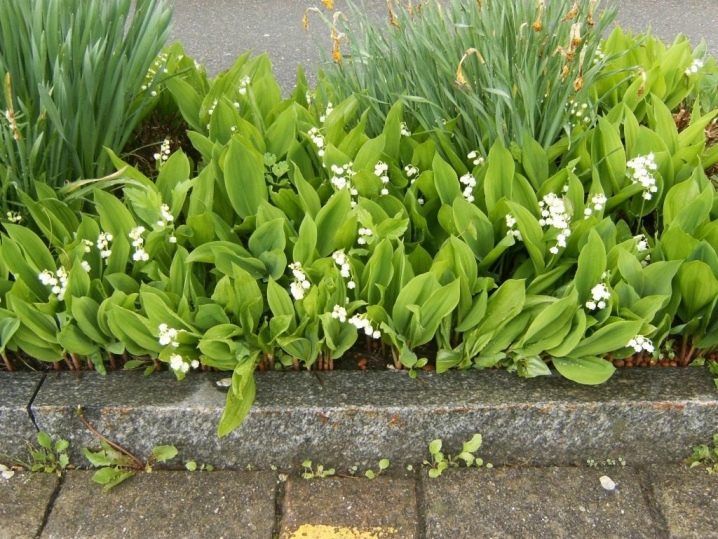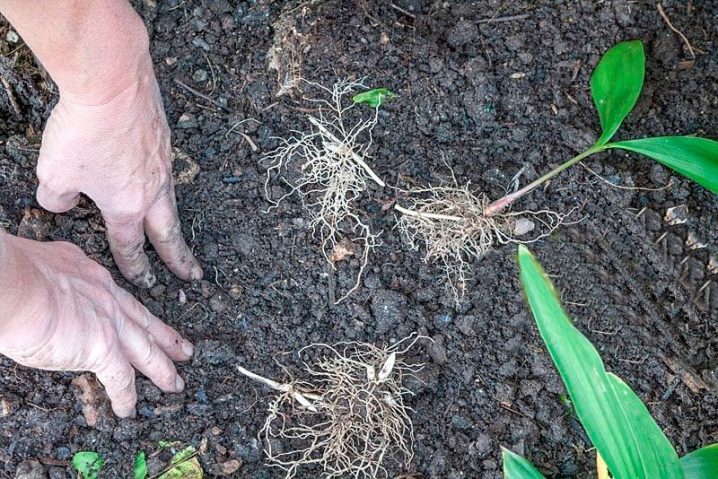When and how to transplant lilies of the valley to a new place?

Lilies of the valley do not need frequent transplants, however, if they have been growing in the garden for more than 5 years, it is necessary to know when and how to transplant these delicate flowers to a new place.

Dates and choice of location
Until the age of 5, it is better not to disturb the plant with transplants. Lilies of the valley are transplanted:
- with the aim of rejuvenating the flower bed - after 5 years;
- Anytime, if the flowers do not feel well, or the layout of the garden changes.
If a very traumatic transplant is planned, for example, a flower was brought from the forest, it is better to perform the procedure in September. The plant adapts faster.

Sometimes in the literature it is recommended to transplant garden lilies of the valley in the spring. A transplant in April or May can indeed be very successful. The plant is actively gaining green mass, quickly takes root.
However, many practitioners prefer to transplant lilies of the valley in the fall. Plants have time to prepare for winter, and the spring load on the gardener is reduced. And in the spring, green buds can be damaged. In summer, the flower is not transplanted, you need to wait until the ground part is completely dry.
To make the lilies of the valley bloom faster, the transplant is performed as carefully as possible. Blossoms transplanted in spring will bloom in 2-3 years or next spring - it depends on the buds chosen. The vegetative method in any case will give a faster result than reproduction of lily of the valley by seeds - seedlings bloom only after 6-7 years.

Thus, lilies of the valley can be transplanted to a new location either in April or in September. Which method is better is decided by a specific florist in a specific area.
In shady, humid areas, lilies of the valley very quickly form dense clumps. This flower is beautiful, but in the USA and even in some regions of Russia it is becoming invasive. Lily of the valley really does not like the neighborhood with other plants, over the years it forms dense clumps, into which other cultures cannot penetrate. When choosing a place in the garden, one should take into account its bright personality.
It is best to give him a clearing among the trees, shady or semi-shady, spacious, with light soil.

Lilies of the valley tolerate any soil, except saline or waterlogged. A light, fluffy loam of low to medium acidity is best suited. If the soil is acidic, it is dug deeply, adding 150-250 g of slaked lime per 1 square meter. m. However, this is not very important. Botanists classify lily of the valley as an indifferent species; in nature, this flower is found on soils with any acidity.
Poor soils are fertilized by introducing 1 bucket of humus, 2 tbsp. l. superphosphate and 1 tbsp. l. potassium sulfate per 1 sq. m. Too salty soils are gypsum - add a glass of gypsum per 1 square meter. m. Dig it up and wait 2 weeks. After 2 weeks, the area is spilled very well with water - so that the soil is wet by at least 70 cm. Gypsum will make the salts soluble, and they will go away with the moisture. It is better not to use heavy soils, the soil should be capacious for moisture and at the same time breathable well.

Site selection is the first condition for successful transplantation. The place is shady but not gloomy. Lilies of the valley do not like stagnant air, but drafts and wind are undesirable. Coolness, freshness, oblique scattered rays of the sun are the best conditions for them.
Lily of the valley reproduces well on its own, new plants are formed nearby every year.
If the lily of the valley is planted next to other low-growing crops, it is better to immediately organize restrictors for the growth of its rhizomes - these can be pieces of slate dug vertically into the ground.

Transplant technology
To properly transplant lily of the valley, follow the instructions.
- Cut off dry foliage. It is better to work with a pruner, but not with a rake or with your hands.
- The roots are dug in with an ordinary bayonet shovel. They are located shallow, enough depth for 1 bayonet.
- Plants hook up with the soil, the soil is shaken off.
- Rhizomes are divided into separate parts according to the principle: 1 bud - 1 plant. If you need flowering next spring, choose rhizomes with blunt puffy buds - they have future buds. Blossoms with sharp, thin buds will bloom in 1-3 years.
- Lily of the valley rhizomes are embedded in the soil shallowly: 1.5–3 cm. The same depth should be when planting rhizomes with sprouts. The kidneys should be facing up.

The distance between the lilies of the valley is not less than 15 cm. Between the rows they are kept 20-30 cm. You should not thicken the planting, as the plants are quickly attacked by bacterial rot.
You do not need to water immediately, if the weather is dry, water it after 2 days. In the future, watering is needed only as needed. It is better to avoid waterlogging, the rhizomes can get wet. Young plants take root in a month - during this period it will be possible to feed them 1 time with diluted organic matter. If the fall is rainy, you do not need to water and fertilize.
Pulling weeds can disturb rooting plants, so they are removed carefully after watering, and not pulled, but pulled out of the ground.
Shortly before the cold weather, mulching the soil will be useful, especially if more delicate garden varieties have been transplanted.

If there is a risk of damage to plantings by rot, the soil is spilled with "Fitosporin". It contains spores of bacteria that naturally inhabit soils. Watering with ash infusion will also improve the soil (1 glass of ash is diluted in 10 liters of hot water, insisted for several days, stirring regularly, and filtered). Ash lowers the acidity of the soil and nourishes the plants with potassium.
The plant is almost not sick. The most common enemies of the lily of the valley are botrytis (gray mold), sclerocial rot and nematodes. It is quite difficult to notice the defeat of lily of the valley by gray mold. It affects the underground organs, leaves will begin to lay down on the top of the plant, when the roots are already pretty badly damaged. Rot damage will be noticeable by brown spots on the leaves, and due to nematodes, the plants will be weak, with faded leaves.

Disease prevention is not difficult, and it is better to start it immediately when planning a transplant. The development of diseases is facilitated by thickening of plantings, lack of fresh air, excess nitrogen fertilizers, lack of light, insufficient quality autumn harvesting. In autumn, dry lily of the valley leaves are best removed and burned.
Nematodes are distributed with planting material, therefore, before transplanting plants from an unfamiliar nursery or forest, it is better to treat them with hot water - the dug out cuttings are kept in water at a temperature of + 43.5 ° C for 1 hour.

Useful Tips
The sap of the plant can cause serious irritation to the skin, therefore it is better to work in equipment: protective gloves, a mask for the respiratory system, transparent glasses. If you need to drive out lilies of the valley in winter, the cuttings prepared in the fall are immediately planted in a suitable dish. The soil mixture is composed of leafy soil (1/3) and equal parts of peat, well-rotted sawdust and sand. Delenki are planted in this soil to a depth of at least 3 cm, watered well with water and placed in a cool place with a temperature of + 3 ... + 5 ° C.
You can not plant the cuttings in the soil, but wrap them with moistened sphagnum, and then with a film. In this form, the rhizomes are perfectly stored in the refrigerator. For early distillation (by the New Year), the buds will have to be frozen: hold for 3 weeks at temperatures from 0 to -2 ° C. This will help wake them up faster.
Then the rhizomes are heated for 12 hours in a warm bath at + 30 ° C. The water is changed several times. Freezing is not required for distillation by any date after January 15th.

After warming up, the rhizomes are planted in pots with loose soil.Watered with warm water and placed in a place with a temperature of + 28 ° C. Seedlings are shaded with paper, they are removed only when leaves appear, or flower stalks reach a length of 10 cm. Seedlings adore spraying with warm water.
Then the plants are transferred to the north, east or west windowsill so that there is no direct sun. The paper is removed, the temperature during this period is desirable + 16 ... + 18 ° С. Delenki with the plumpest buds are selected for distillation.








































































































The comment was sent successfully.